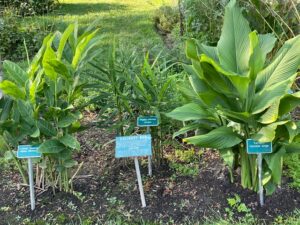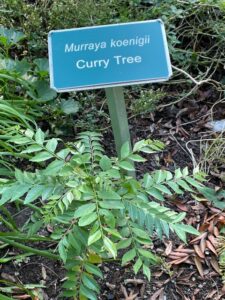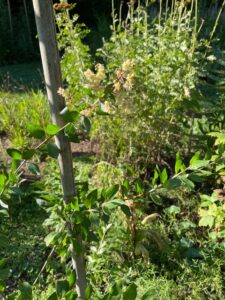The Herb Garden, located on the south side of the Formal Rose Garden and east of the Perennial Garden, offers a tranquil place to stroll any time of year. In August and September, the warm, humid weather adds enjoyable fragrances to the visual display. Among the many familiar herbs, which are planted in nine thematic beds, keep an eye out for some of the more exotic herbs native to the tropics of South and Southeast Asia.
In the culinary bed you will find three aromatic herbs with edible tuberous rhizomes: turmeric (Curcuma longa), ginger (Zingiber officinale) and galangal (Alpinia officinarum). All three belong to the Zingiberaceae or ginger family. They are important to Asian culinary and medicinal traditions. This time of year, you might catch the turmeric in bloom — its flowers hiding under the plant’s leaves.
Another South Asian herb in the culinary bed is the Curry Tree plant (Murraya koenigii). Its aromatic leaves are used to flavor dishes in India, Sri Lanka and Indonesia. This plant is not to be confused with the similarly named curry plant (Helichrysum italicum), which is native to the Mediterranean and looks very different.

In the tea bed, you will find three kinds of holy basil or Tulsi (Ocimum sanctum). Crush and smell a leaf to experience its strong fragrance.
In the dye bed, if you look carefully, you will find a plant popularly used in Asia and Africa since ancient times for coloring hair, skin and fingernails. It is the Henna Plant (Lawsonia inermis). The leaves of this plant are dried and powdered for use as dye. It is pictured in the picture on the right, in front of the stake.

As summer winds down, other plants of note that are putting on a dazzling show in the Herb Garden are the Calamint, Joe Pye Weed and Mountain Mint. Pause and watch the innumerable bees, wasps and butterflies on their flowers!
